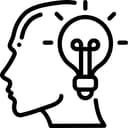
Epilepsy
Neurofeedback has been used as a complementary approach to epilepsy management, aiming to regulate abnormal brainwave patterns that may contribute to seizures.

Substance Abuse
Neurofeedback has been investigated as part of addiction treatment, targeting brain functions related to impulse control and emotional regulation.

Anxiety Disorders
The relaxation-promoting effects of neurofeedback have led to its application in reducing symptoms of anxiety and stress. Neurofeedback can target specific brainwave patterns associated with anxiety, such as excessive beta activity in the frontal regions of the brain and decreased alpha activity in the parietal regions. By providing feedback to the individual about their brainwave patterns in real-time, neurofeedback training aims to help them learn to modulate these patterns and promote greater balance and stability in brain functioning.
Speech disorders
Language disorders are conditions that affect a person's ability to understand, produce or use language appropriately. They can occur in children or adults and can include difficulties with speaking, understanding language, reading and writing.

Attention-Deficit/Hyperactivity Disorder (ADHD) in Adults
Neurofeedback has gained attention as a potential treatment option for Attention-Deficit/Hyperactivity Disorder (ADHD), a neurodevelopmental disorder characterized by symptoms such as inattention, impulsivity, and hyperactivity.

Social Anxiety Disorder (SAD)
Targeting Brain Regions Implicated in Anxiety: Neurofeedback protocols for SAD often focus on brain regions associated with anxiety regulation, such as the amygdala, anterior cingulate cortex (ACC), and prefrontal cortex (PFC). By training individuals to modulate their brainwave patterns in these regions, neurofeedback aims to reduce hyperactivity and enhance regulation of fear and anxiety responses.

Bipolar Disorder
Reducing Mood Swings: Bipolar disorder is characterized by fluctuations between episodes of mania (elevated mood, increased energy) and depression (low mood, decreased energy). Neurofeedback training may help individuals with BD achieve greater balance in their brain functioning, reducing the frequency, severity, and duration of mood swings.

Traumatic Brain Injury (TBI)
In some cases, neurofeedback has been explored as a part of rehabilitation programs for individuals with traumatic brain injuries to enhance cognitive function and recovery.

Post-Traumatic Stress Disorder (PTSD)
PTSD often involves heightened emotional reactivity and dysregulation. Neurofeedback can target specific brainwave patterns associated with emotional processing, such as reducing hyperarousal (excessive activation) in the amygdala and enhancing frontal lobe activity involved in emotion regulation. By learning to modulate these brainwave patterns, individuals may experience improved emotional stability and resilience.

Obsessive-Compulsive Disorder (OCD)
Neurofeedback can target specific brainwave patterns associated with OCD symptoms, such as excessive beta activity in the frontal regions of the brain. By providing feedback to the individual about their brainwave patterns in real-time, neurofeedback training aims to help them learn to modulate these patterns and promote greater balance and stability in brain functioning.

Personality Disorders
Neurofeedback can target specific brainwave patterns associated with emotional processing and regulation, to help them learn to modulate these patterns and promote greater stability in emotions, learn to down-regulate hyperarousal in brain regions associated with impulsivity and increase activity in regions involved in inhibitory control and decision-making.

Autism Spectrum Disorder
Neurofeedback training can help individuals learn to increase activity in brain regions associated with attention and executive function, such as the prefrontal cortex. This may lead to improvements in sustained attention, selective attention, and task performance, can help individuals learn to regulate their emotions and improve social skills.

Neurodevelopmental Disorders
Neurofeedback is Regulating Brainwave Patterns, Improving Attention and Focus, Enhancing Cognitive Functioning, Reducing Hyperactivity and Impulsivity, Addressing Sensory Sensitivities.

Depressive Disorder
Neurofeedback aims to train individuals to modify their brainwave patterns, such as increasing alpha waves associated with relaxation and reducing beta waves associated with stress and anxiety. By learning to regulate their brain activity, individuals may experience improvements in mood, emotional regulation, and overall well-being.

Neurocognitive Disorders

Attention Deficit Hyperactivity Disorder (ADHD) in Childhood
Neurofeedback is often used to help individuals with ADHD improve their attention, focus, and impulse control.

Intellectual Disability (ID)
Neurofeedback training can help individuals improve learning abilities by targeting brainwave patterns associated with neuroplasticity, synaptic connectivity, and information processing. This may lead to greater receptivity to learning experiences and increased skill acquisition.
G
Generalized Anxiety Disorder (GAD)
P
Phobias

Sleep Disorders
Neurofeedback has been investigated as a potential treatment for sleep disorders, targeting specific brainwave patterns associated with sleep quality.

Peak Performance Enhancement
Athletes, musicians, and other performers may use neurofeedback to optimize cognitive and emotional states for peak performance.

